All may look quiet around Futility Central, but that’s only because after a brief Xmas respite following 26 straight working days, I’m busy putting my pedal to the metal to finish this year’s JAWS series on the Hall of Fame candidates at Baseball Prospectus. In case you’re looking for a quick set of links as to where they can be found, you’re in luck:
• Starting Pitchers: Bert Blyleven, Kevin Brown et al (leiter).Will this be the year Blyleven gets in? I certainly hope so. I’m starting to fear that Jack Morris is picking up Jim Rice-level momentum though he’s nowhere near as deserving.
• First Basemen: Bagwell and Baggage. It’s unbelievable to me just how many writers have come out of the woodwork to make Jeff Bagwell — a player who never tested positive for steroids, never was named in an investigation related to steroids, never was leaked among the supposedly anonymous list of 104 players who tested positive during the survey testing — has been made the water boy for the collective failure of the players union, owners, commissioner and media to address the steroid problem coherently. The Hall of Fame debate surrounding him lays bare the great divide between those of us who adhere to “the search for objective knowledge about baseball” — the very definition of sabermetrics — and those who prefer witch-hunting. It’s the season of the witch for Jeff Pearlman, Danny Knobler, Dan Graziano and so many others willing to put hearsay, innuendo and Ye Olde Eyeball Test ahead of facts; their justifications speak so poorly of their own character that they should refrain from judging those of others. Kudos to Joe Posnanski for nailing them and so many others, and for going a perfect eight-for-eight versus JAWS when it comes to his definites. Colleague Christina Kahrl nailed it, too:
The problem of sportswriters investing themselves with too much significance in the process and belated paragons of probity is just another manifestation of the Chinese water torture that trails every “new” revelation about who tested positive seven or eight years ago, before a comprehensive testing regime was part of MLB’s operations and practice. After missing history instead of recording it, only to see the industry itself tardily address the problem of PED use, it’s as if the sportswriting community can’t spend enough time wailing about what happened then to make up for lost time. Having so thoroughly, absolutely, and completely failed to produce history’s first draft, it seems as if any number of writers are investing in a narcissistic thrill-kill, avenging themselves on the game’s history by assuming a moral responsibility they already shirked. Steroids stopped being a relevant or timely issue years ago, having long since been reduced to self-absorbed media navel-gazing: What didn’t we know, and how long didn’t we know it, and now I’m belatedly mad as hell now that I no longer need to dig a quote out of this guy.
• Second Basemen: Roberto Alomar’s Second Chance. After finishing eight votes short in his first ballot appearance, Alomar should get over the top.
• Shortstops: No Shortage of Quality. Both Barry Larkin and Alan Trammell are worthy of votes, but while the former cleared 50 percent in his ballot debut last year, the latter reached just 22 percent in his ninth year on the ballot.
• Edgar Martinez: In both ESPN and Baseball Prospectus flavors, I put forth the argument that Martinez was the Mariano Rivera of DHs: so good within his limited role that he produced enough value to transcend it. In writing up Edgar’s career, I discovered that his most famous hit, his 1995 ALDS-winning double, has its own Wikipedia page, putting him in very select company.
• Bronx Bombers on the Ballot: At Pinstriped Bible, I made a quick rundown of the former Yankees who are up for election. With the exception of Tim Raines and maybe Kevin Brown, none of them are particularly strong candidates, but they’re fun to write about nonetheless.
I’ve still got to polish off the outfielders (Raines and Larry Walker being the most interesting) and the relievers before next Wednesday’s announcement of the voting results. Wait ’til next year, as they say…
In the meantime, thank you, dear readers and Twitter followers, for your support in 2010, and best wishes to you for a happy and healthy 2011!



